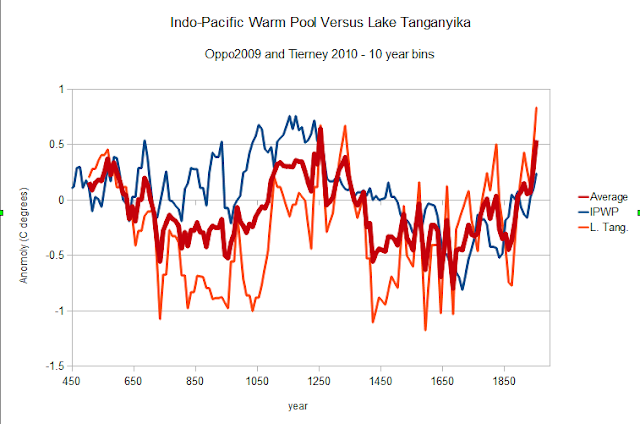The IPWP recon was assembled in decade data points with 50 year averaging of the data points. For sea floor sediment proxies, that is a good "standard" for the natural smoothing which is the time period required to form a sediment layer. I was not all that trilled with the decade "pseudo data points" but on second thought, it might be an elegant solution for the splicing.
To check out how it might work I calculated the centered decade averages for the Hadley Center HADCRUT4 data set using the NH, SH and 3030 or tropical zone. The overlap period for the Oppo 2009 data and HADCRUT4 is 1855 to 1955. I used that as the anomaly baseline period. That is what the instrumental data would look like in order to do the splice.
Because of the different smoothing periods, the splice is off a bit.
By shifting the IPWP recon back one decade, the splice appears to be better centered. That shifts the anomaly baseline period a touch though.
So just to be thorough, this chart shows both the time shift and new anomaly baseline period, 1855 to 1945. That is not a bad fit in my opinion, but I am sure there is probably a better way.
Tah Dah! There is the tropical instrumental to Indo-Pacific Warm Pool Splice. Doesn't look much like the more famous hockey sticks for some reason. If you are a fan of ENSO and long term persistence in climate though, it may be a lot sexier.
Data:
WDC PALEO CONTRIBUTION SERIES CITATION: Oppo, D.W., et al. 2009. Makassar Strait 2,000 Year Foraminiferal SST and d18Osw Reconstructions.
IGBP PAGES/World Data Center for Paleoclimatology Data Contribution Series # 2009-089.
NOAA/NCDC Paleoclimatology Program, Boulder CO, USA.
http://www.cru.uea.ac.uk/cru/data/temperature/
UPDATE:
Here is another high resolution paleo reconstruction along with the Oppo 2009.
The Lake Tanganyila Lake Surface Temperature by Tierney et al. 2010. This was a poster child for scary "unprecedented" warming. Don't be too alarmed, the margin of error is pretty large in their reconstruction and "lake" is a buzz word for look out for land use impacts. Tierney has a longer 66,000 year Lake Tanganyila reconstruction that only have a couple of data points over lapping this 1500 year recon. There is a "gap" of about half a degree between the two. As you can see, the variance, aka standard error, is larger than Oppo, but it still is possibly a useful data series.
The Tierney 2010 data is not in consistent bins, the dates vary from about 18 years to over 30 years. That means that the smoothing per data point would also be inconsistent. So I arranged the Tierney data by date to the closest 10 year bin used by Oppo et al. In order to Average, simple interpolation between dates with data was used. In most cases only one date was missing data, but in a few there were two dates missing, so each received the same simple interpolation, not fancy spline fits and such. This is the result with no temporal shift as above. Even allowing for various things that could impact the accuracy of each reconstruction, there is evidence of a lead/lag relationship that is a little complex. It looks like adding more reconstructions will smooth out most of the information producing a smoother shaft for a hockey stick. The phase may shift between the reconstructions, but the range is remarkably consistent, that may be more important than the timing.







No comments:
Post a Comment